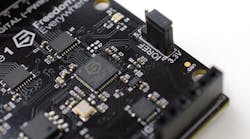The RISC-V architecture is taking root in the semiconductor industry. That was reflected Monday in the announcement of $50.6 million raised by SiFive, a startup that has been leveraging the open source architecture to reduce the cost and manpower required for chip development.
SiFive is one of the most closely watched companies trying to build a market for open source hardware. SiFive provides support around the RISC-V architecture, making it easy to commission custom chips for Internet of Things devices, data centers and other applications. The company plans to release a cloud platform with prototyping, verification and other tools as well as templates that chips can be designed around.
The target customers are all the semiconductor companies strapped for the millions of dollars of cash required to prototype chips based on ARM, MIPS or other architectures. SiFive is also targeting systems companies that have neither relationships with foundries nor chip design expertise, like placement, partitioning, packaging and routing.
“If we make prototyping lower cost and faster, more people will do it,” said Naveed Sherwani, chief executive officer of SiFive, in an interview Monday. “We expect that nine out of 10 chips will not be successful, but the one that does can make money for our customers, our investors, and our intellectual property partners, [and us]. ”
SiFive’s focus is on simplifying the prototyping process. Sherwani said that it can take more than seven months to design a new processor, in addition to two months for manufacturing. The average cost of prototyping a 28-nanometer chip, he said, is around $7 million. SiFive is trying to reduce prototyping costs by 90 percent and cram the design process into a single month.
To that end, the company charges less than a million dollars for companies to use its customized RISC-V cores. SiFive has expanded its DesignShare program, which provides intellectual property from companies including Rambus and Think Silicon at lower-than-normal costs. That allows SiFive’s customers to delay certain costs until after production.
SiFive’s customers are still required to pay licensing fees on every chip they ship. “Our revenue model should be attached to chips that actually go to production, and this is exactly what happens in the software industry,” Sherwani said, adding that “if we attach our revenue model to prototyping, we kill that business.”
“We want to change the whole chip design experience,” Sherwani said. “Because a small team can prototype software, there have been hundreds of thousands of startups in the software space. But we don’t have that in silicon because it costs millions of dollars just to prototype.”
SiFive was founded two years ago by Krste Asanovic, Yunsup Lee and Andrew Waterman, the researchers that created the RISC-V instruction set architecture, which is the basic list of functions a chip can carry out. Last year, the company, which compares itself to Red Hat Software, raised $8.5 million to bring its open source-based business model to hardware.
The company is trying to convert the growing use of RISC-V into a profitable business. Greenwaves, Esperanto and other machine learning chip startups are playing around with the architecture to get around the rising cost of chip design and slowing manufacturing advances. Nvidia recently said that it would use RISC-V in the Falcon controller in its graphics chips.
The members of the RISC-V Foundation include Google, Microsoft, IBM and Oracle. Technology news website The Information recently reported that Tesla had also joined the foundation. But more companies using the open source architecture does not automatically mean more business for the San Mateo, California-based SiFive.
The challenge for SiFive is to drive customers to its chip design factory in the cloud. Sherwani said SiFive plans to double its 50-person headcount over the next two quarters, and it wants to hire employees with expertise in software tools used to troubleshoot integrated circuits. The company plans to roll out its cloud environment to early customers before the end of the year, with general availability next year.
Last year, the company hired Sherwani, a founder of Open Silicon, one of the first contractors for ASICs. In January, SiFive bolstered its executive team with Shafy Eltoukhy, vice president at Microsemi and the former head of operations at Open Silicon, where he released to production over 150 ASICs and custom SoCs. The company also recently hired its first C.F.O.
Helping SiFive with additional hiring and development is the $50.6 million that it raised from existing investors Sutter Hill Ventures, Spark Capital and Osage University Partners as well as new investors Shanghai-based Chengwei Capital and Huami, one of Chinese electronics giant Xiaomi's major suppliers. Huami's subsidiary, Abee Semiconductor, has created a RISC-V CPU for wearable devices.
SiFive announced that another new investor, Western Digital, had agreed to license the company’s Freedom technology for the next several years. Last year, Western Digital pledged to produce a billion RISC-V cores in its hard disk drives and other memory products. These cores will not run application software, but the company's decision is another boost for RISC-V.

